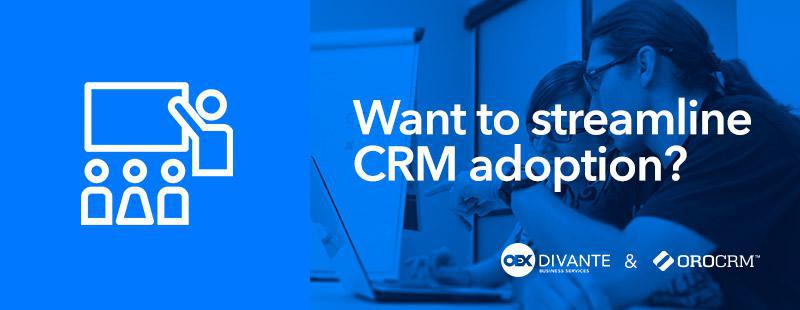
The long-awaited day finally arrives and the new CRM tool is handed over to the staff. Have you ever wondered what their first day will look like? Or how they will rate the new CRM tool after a week? What about after they spend a month with it?
Don’t let them go back to the old version
A common problem when adopting a new CRM system is for employees to initially resent using the new system. However, it’s natural for them to be hesitant at first, especially since the decision to switch to the new CRM is usually made high up in the corporate hierarchy, away from the day-to-day operations. Luckily, you can easily prevent this from happening.
Engage users from the beginning
When designing a new CRM, it’s important to include the end-users as early as possible. Doing so will help them feel like a part of the project and make it easier for them to accept it as their own. However, this can be tricky since CRMs are so complex — end-users may not know enough about a certain aspect of the business to contribute. This is why it is ultimately up to the User Experience (UX) designers to incorporate input from a variety of stakeholders, while keeping in mind those who will be using the final product. They need to bring everyone together, figure out what problems the CRM design should solve, and have the whole team — from engineers to end-users — agree on what the final product should be.

Host a CRM UX workshop
It’s time to get together and exchange knowledge. If you want to avoid lengthy, boring, and potentially fruitless meetings, try asking your UX designer to run a workshop. Most importantly: invite end-users to participate. Make sure they know they are there to freely express their opinions on the system they are currently using so that you can improve on the next. Make them feel comfortable by encouraging them to list their pain-points and describe their everyday struggles. Withhold any judgment as their supervisor. Instead, emphasize how important their contributions are. The information you gather from these sessions will enrich the project by giving you insight into the end-users’ perspective. If this is done at the beginning of the CRM design process, it will help you find the right design more quickly and effectively.

Ready, steady, co-create!
The themes and activities of a workshop will depend on the stage of the development process in which it takes place. Fortunately, UX designers know plenty of methods to engage stakeholders so that they communicate ideas and define the real problems the CRM system for omnichannel retail should solve. The following are some of the best techniques for making your design meetings as effective as possible, ensuring that everyone is working towards a common goal.
Kick-off meetings
When: At the beginning of a project, or at a significant part. These meetings may introduce the whole CRM design process, but may also be focused on a particular feature (or set of features) to design.
How: UX designers select the tool suiting the project best. It may be the Value Proposition Canvas, Service Blueprint, Personas, Affinity Diagrams , or many other techniques that support both creativity and analysis.
Why: To collaborate effectively, the team needs to have some shared knowledge. This is the perfect time to ensure consistency so that everyone shares the same vision for the project.
Experience Mapping
When: Early in the process, before any decisions concerning features and user needs have been made.
How: A UX designer invites the stakeholders to step into a CRM system users’ shoes and analyze their daily (or weekly, or monthly) journey in the company and the role of the CRM plays. The experience, with its best and worst parts, is then mapped onto big sheets of paper, providing a tangible illustration of the ecosystem that is being changed.
Why: To understand the complete experience a person may have with a product or service and to act upon this knowledge later in the process, making any future decisions more informed and user-focused. Depending on the project, the team may focus on the present state or describe the perfect experience in the ideal world. Both perspectives add value to the design process. In today’s multichannel world, this is one of the best way to analyze, draw conclusions, and strategize.
Problem-focused workshops
When: In the middle of a design process, as a creative meeting during a sprint.
How: The UX Designer invites multiple stakeholders, including IT people and end-users, to work together to solve a problem they agree needs to be addressed. It may be the hierarchy of the information, the layout of the screen, or a particular way an interaction flows in the application. The most engaging and informative activities for these types of meetings are Design Studio, Storyboarding, Card Sorting, The Role Play, Character Profiles, and Personas.
Why: A workshop is the most natural and effective way to get people to express their needs and constraints, ask questions, and address problems. It is also a great opportunity for everyone to be reminded of who will be using the final product. To do this, a UX designer gathers together their multidisciplinary team and makes sure they are all heading toward a common goal. By facilitating these workshops, UX designers get people to express their thoughts and knowledge in a structured, yet engaging, way. They all need to share:
- End-users know what is most important to their workflow, what they need in order to sell products, what information they are looking for, and what kind of conclusions they need to draw.
- Business owners provide a strategic perspective that can optimize the workflow according to larger corporate goals.
- IT specialists make sure the system conforms with technical requirements.
- UX Designers help everyone communicate, ask questions, and gather information. They give meetings a meaningful structure so that they can discover patterns and define solutions for what the product should be.
Want to know more about CRM UX workshops? Download the whitepaper “UX for CRM”.
About the Author
Founded in 2008, Divante eBusiness Software House delivers high quality eCommerce solutions with expertise in CRM, ERP, PIM, custom web applications and Big Data solutions. With over 150 experienced specialists on board, Divante provides a wide range of services, from complete B2B and B2C eCommerce development using the world’s best technologies, like OroCRM, Magento, Pimcore and SAP Hybris, to a comprehensive package of research, analysis, and marketing services.
Anna Sorbian
Anna is a UX Designer constantly looking for new UX ideas while she crafts responsive, cross-platform and omni-channel experiences. She is passionate about the crossroads of business, design, and psychology, and perceives UX design as a process to deliver a customer value proposition. Through research, she reveals the experiences that users desire in order to optimize digital products for success in the marketplace. As a passionate UX evangelist, she enjoys teaching people how the goals of sales, marketing, and engineering can all be achieved through great user experiences.





